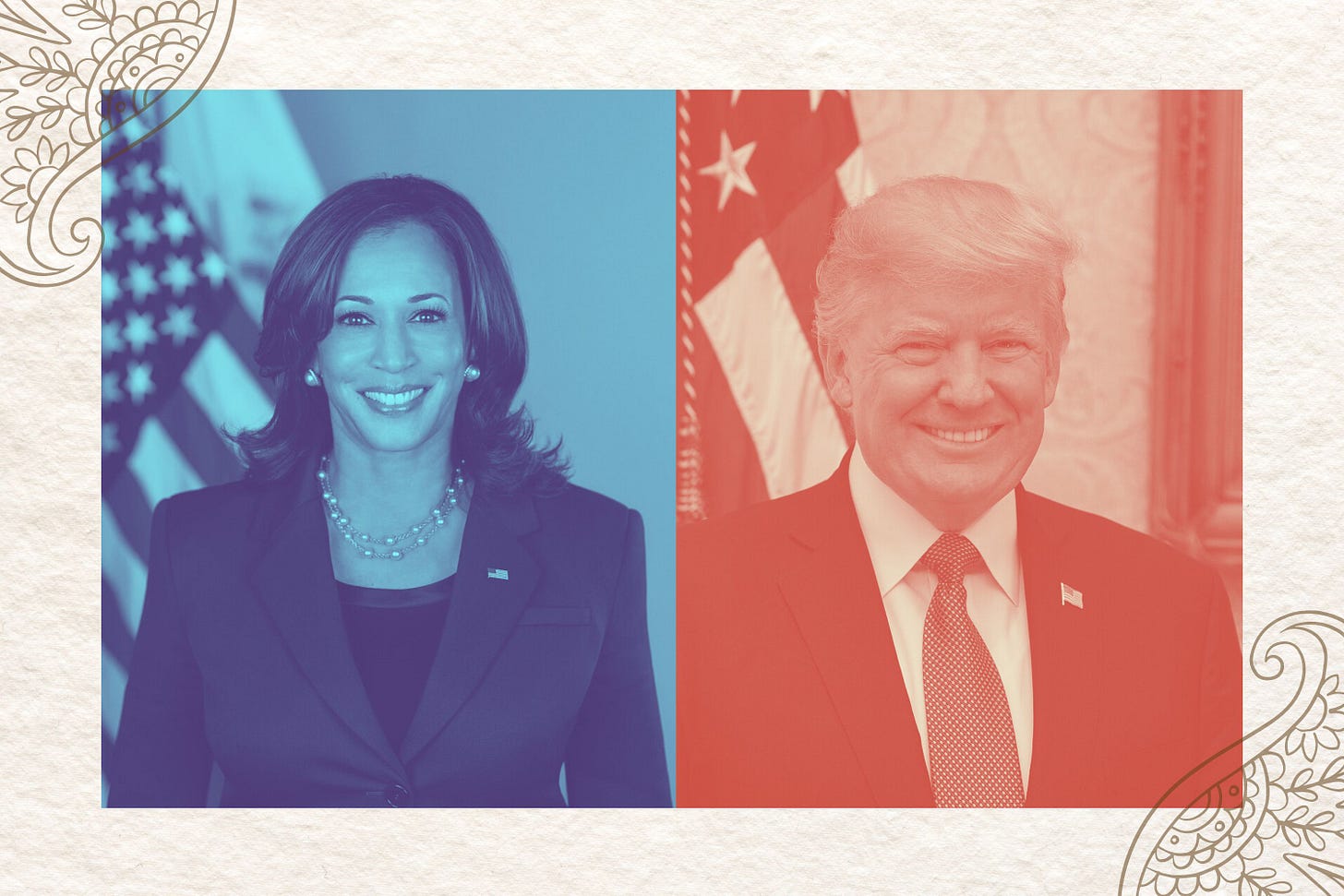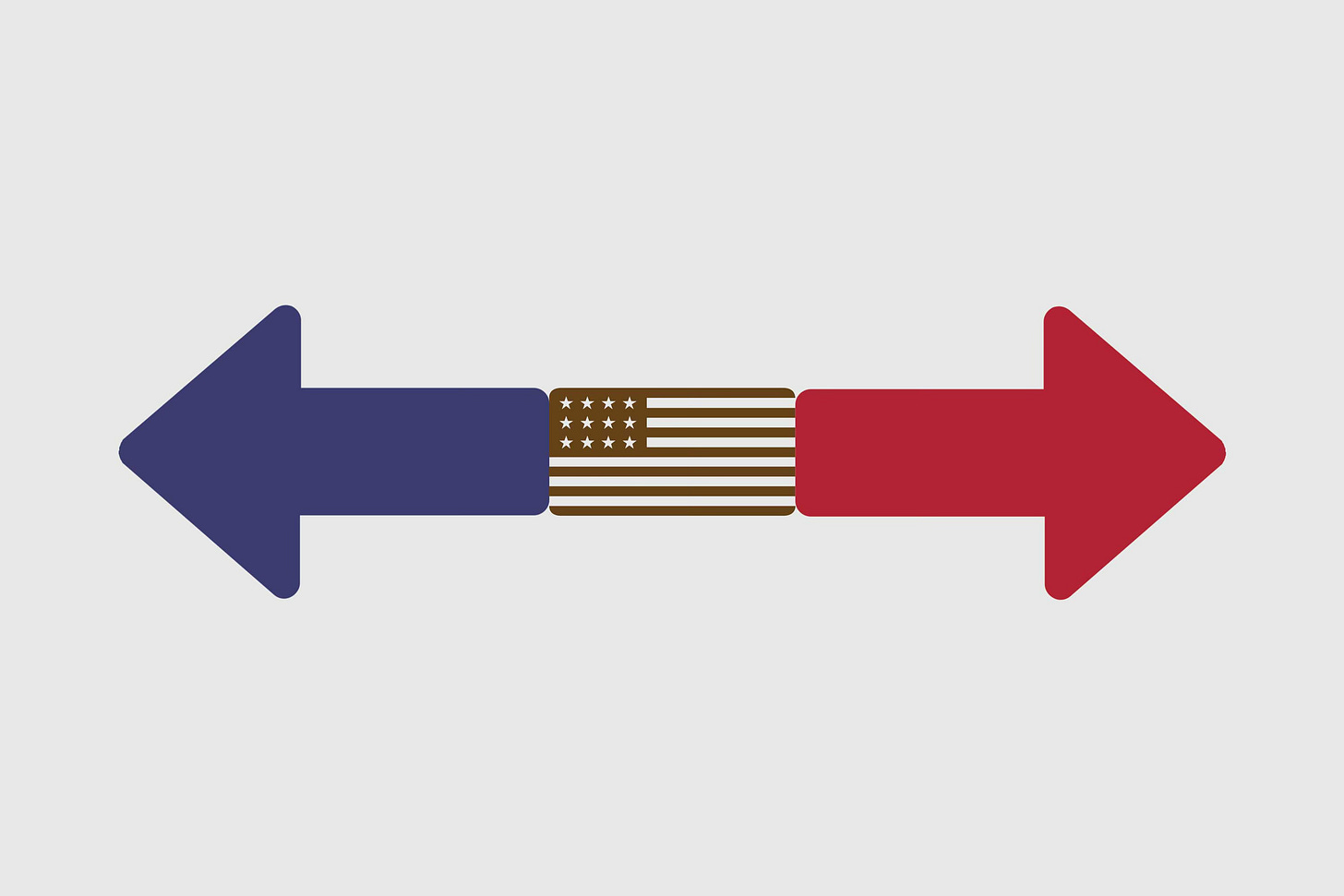Why desis could sway the election
South Asian American communities outnumber the closest margins of victory in the 2024 U.S. presidential election’s battleground states.
Issue #82
Hi all —
Happy Election Day, 2024.
“Battleground states” that could go for either candidate will basically decide today’s presidential election: Nevada and Arizona in the west. Georgia and North Carolina in the southeast. Wisconsin, Michigan and Pennsylvania in the “Rust Belt.”
Either Vice President Kamala Harris or former President Donald Trump have to get enough of those key states (in gray below) to get over 270 electoral votes to win.
But while polling pundits have been talking about the influence of suburban women, young men, Black populations and Latinos as key blocs in these swing states, they have been mostly overlooking this: There are over 400,000 eligible South Asian American voters in Arizona, Georgia, Michigan, North Carolina and Pennsylvania, a number large enough to be decisive. In 2016, Trump won Michigan by just 10,704 votes. In 2020, Biden won Georgia by just 11,779 votes and Arizona by only 10,457 votes. Desis could be a big part of moving the results either way.
For New Lines Magazine, I recently reported on the growing political power and voting trends of Indian American communities, in particular. Here are the most interesting highlights from the story:
A majority of Indian Americans are still voting Democrat, but there is a small shift rightward: About 3 out of 4 Indian Americans voted for Democrats Hillary Clinton in 2016 and Joe Biden in 2020. A new Carnegie Endowment for International Peace survey found that 61% of respondents said they would vote for Harris, compared to 32% for Trump. Trump’s share is a notably greater share than what he had in 2020.
While Democrat and left-leaning Indian Americans were likely to support Biden, Harris brought a greater momentum. For example, the Democratic-aligned federal political action committee They See Blue saw the number of volunteers writing postcards balloon from 130 during Biden’s campaign to more than 1,000 once Harris took control of the ticket. Also, several different types of groups from South Asian communities — men, women, writers, comedians — have been organizing large videoconference meetings for Harris.
A chunk of Indian Americans are moving rightward — especially young men. The Carnegie survey found among Indian Americans under age 40: 62% of young women support Harris and 29% support Trump. But among young Indian-American men, 48% prefer Trump while 44% support Harris. This gender and age dynamic is similar to trends found among other races and ethnicities, and is especially notable in this case, considering that the same survey in 2020 found Biden had a 40-point lead with men under 40.
Among Indian Americans who support Trump, they are more likely to be born in the U.S., compared with Harris supporters, who are more likely to be naturalized citizens. This is from the sample in the Carnegie survey, but it is fascinating because it suggests that MAGA (“Make American Great Again”) rhetoric around minority groups may not bother some second- and third-generation voters as much — maybe because they see themselves as more in-group.
Some Indian Americans who lean toward Trump cite illegal immigration and economic concerns as their deciding factors. But here’s one irony: After Mexico and El Salvador, the largest unauthorized immigrant population in the U.S. is from India, according to 2022 data.
Most desis vote on domestic issues here at home. U.S.-India relations matter less to Indian Americans than some believe. In Indian American Impact’s survey focused on voters in the battleground states of Arizona, Georgia, Michigan, North Carolina and Pennsylvania, 59% of Indian Americans said they trust Harris more than Trump to handle the U.S.-India relationship. But survey participants indicated that their top issues were actually the U.S. economy, inflation and abortion, which 76% of voters in the poll said should be legal all or most of the time.
Young voters, in particular, are angry about the U.S. approach to the war in Gaza and the corresponding Palestinian humanitarian crisis. Some Gen-Z and younger millennial voters have a deep sense of disillusionment about the political establishment and may vote against Harris and for Trump, for a third-party candidate, or not at all.
Trump’s reign of the GOP is holding back a more significant rightward shift. As long as the Republican Party remains Trump’s MAGA party, with hysteria around immigration and changing demographics, any significant push to the right is likely to be hindered. Experts believe the party would need to tone down some of its rhetoric around othering, immigration and Christian nationalism, in order to grow its South Asian American numbers.
Harris’ rise, along with Usha Vance in the spotlight, have inspired some hate. Stop AAPI Hate, an advocacy group that emerged out of the COVID-19 pandemic-driven spike in anti-Asian hate, found that online hostility — slurs, slogans and phrases — toward South Asian American communities has been rising, including racist accusations of stealing jobs and raping women.
The “samosa caucus” in Congress will likely grow. Democratic Reps. Ami Bera and Ro Khanna of California, Pramila Jayapal of Washington, Raja Krishnamoorthi of Illinois and Shri Thanedar of Michigan currently make up the Indian Americans in Congress. It could expand to seven if candidates Amish Shah from Arizona and Suhas Subramanyam from Virginia are successful.
Desi populations are continuing to grow and cannot be ignored as key voters. Indian Americans make up only about 1.5% of the U.S. population but their numbers grew by more than 50% between the 2010 and 2020 censuses. Between Harris and Usha Vance, there will once again be a person with Indian roots in the next White House administration.
Thanks for reading,
Vignesh
Red, White and Brown Media facilitates substantive conversations through the lens of South Asian American race and identity — via journalism, social media and events. Please tell your friends and family to subscribe to this newsletter.







